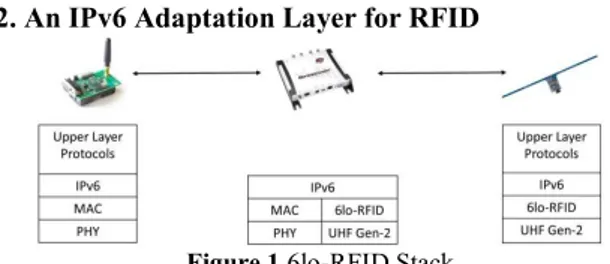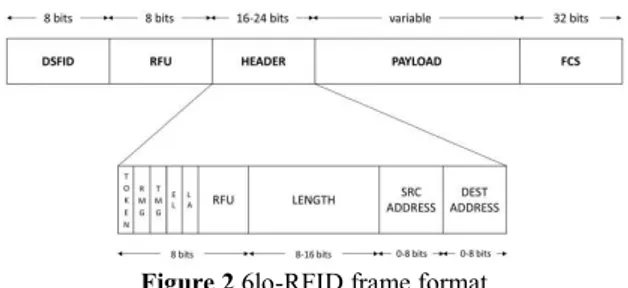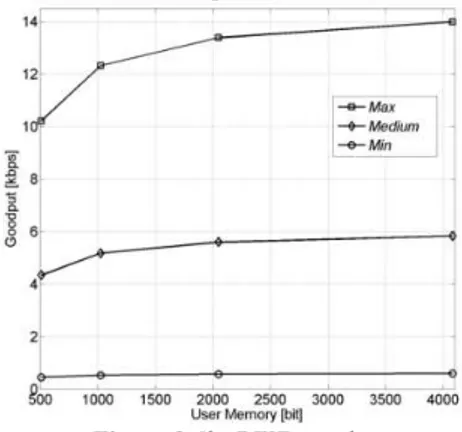IEEE COMSOC MMTC E-Letter
http://www.comsoc.org/~mmc
24/39
Vol.10, No.5, September 2015
A novel IPv6-based approach to exploit the potentials of UHF RFID for Smart Factory 4.0
I. Farris, A. Iera, A. Molinaro and S. Pizzi
[name.surname]@unirc.it
1. IntroductionThe benefits of the Internet of Things (IoT) have been fostering the so-called Industry 4.0, where Smart potentialities offered by Radio Frequency Identification (RFID) tags, sensors, and actuators [1]. In particular, advanced supply chain management is of utmost importance to increase production and to guarantee tracing and monitoring of product quality [2]. To this aim, great attention has been focused on the EPCglobal platform [3], which provides goods information based on the tracking of RFID tag-equipped products in a worldwide integrated architecture. However, the advancements of Ultra High Frequency (UHF) RFID tags [4] in terms of computation, sensing, and actuation capabilities introduce new opportunities, such as enabling real-time direct communications. For instance, in a cold chain, remote systems should be able to query on-the-fly smart tags with embedded temperature sensors to assess the quality of the associated goods. To effectively integrate RFID into IoT, standardized networking interfaces are needed to access RFID resources similarly to those of any other IoT device. A systematic research activity has been conducted by Working Groups (WGs) in the Internet Engineering Task Force (IETF) to define a lightweight IPv6 protocol stack for resource-constrained devices. 6LoWPAN [5], and recently 6lo [6], have addressed the design of suitable adaptation layers to enable IPv6 communication over a wide range of short-range wireless technologies, such as IEEE 802.15.4, Bluetooth Low Energy, and NFC. Besides, the CoRE [7] WG has defined Constrained Application Protocol (CoAP), a RESTful Web transfer protocol for constrained nodes and low-power lossy networks.
In [8], we proposed a CoAP-oriented solution for RFID inclusion in the IoT, where RFID tags are directly accessible via a reader that acts as a CoAP proxy. Although this solution is compliant with legacy RFID devices, it presents little flexibility and scalability due to vendor lock-in
resources, and requires update of the reader firmware when tags are equipped with new resources.
In order to overcome these limitations, in this paper we propose a complementary approach, which leverages the increased computing capabilities of novel smart RFID tags. We introduce an IPv6 adaptation layer to promote standardized real-time communication for long-range passive UHF RFID tags into the IoT. The
proposed architecture maintains complete interoperability with the legacy EPCglobal UHF Gen-2 RFID air interface protocol [3] and overcomes the following relevant limitations: (i) absence of unicast transmissions, (ii) centralized management of the message flow by the RFID reader, (iii) lack of a network addressing strategy to enable routing functionalities, and (iv) limited tag memory and frame size of the standardized RFID commands. In particular, we leverage the paradigm of exploiting the User Memory (UM) as a virtual channel, firstly introduced in [9], so to enable exchange of messages generated by (or directed to) smart tags. Our memory-based approach is not only feasible for and convenient to Wireless Identification Sensing Platforms (WISPs) [4], whose microcontroller (MCU) handles both RFID protocols and sensor measurements, but also to sensor tag platforms wherein the MCU relies on an embedded UHF RFID chip featuring the I2C or Serial Peripheral Interface (SPI) to transfer data
by tag memory [10].
To sum up, the envisaged approach represents a major breakthrough towards IoT smart RFID tags, which will be able to interact with neighbor devices and remote IoT cloud platforms through standardized interfaces. This way, we overcome the idea of RFID applications as stand-alone solutions and foster the new potentialities of RFID technologies in manifold contexts, such as Smart Factories, where interoperability and flexibility are key factors to build highly integrated IoT systems.
2. An IPv6 Adaptation Layer for RFID
Figure 1 6lo-RFID Stack
Figure 1 shows the enhanced protocol stack for RFID systems to support IPv6 over Gen-2 protocol. An adaptation layer, the 6lo-RFID layer, is introduced, similarly to the 6LoWPAN layer for IEEE 802.15.4 networks. The reader operates as an enhanced edge IPv6 router, forwarding and proactively retrieving messages directed to tags. Indeed, according to the terminology proposed in 6LoWPAN standards, the
IEEE COMSOC MMTC E-Letter
http://www.comsoc.org/~mmc
25/39
Vol.10, No.5, September 2015
RFID reader is seen as a 6LoWPAN Border Router (6LBR), whereas tags are equivalent to 6LoWPAN Nodes (6LNs). The adaptation between IPv6 networks and RFID system is transparently and efficiently done in both directions.
6lo-RFID frame format
Our approach foresees the use of the tag UM as a virtual channel to transfer messages generated (directed) by (to) the tag. In other words, we introduce an abstraction of the UM: by overcoming the classic view of a mere container of static information, it is seen as a communication means, compliant to the Gen-2 protocol. To this aim, a novel memory organization is designed. According to the EPCglobal Tag Data Standard [3], the first 8 bits of the UM contain the Data Structure Format Identifier (DSFID) field, which specifies the format of the rest of the UM, to keep compatibility to other RFID data standards. The five least significant DSFID bits represent the Data Format to indicate the data system predominating in UM. Also, a new data format code associated to IPv6 RFID communication is considered for our application.
Figure 2 6lo-RFID frame format
Figure 2 illustrates the proposed UM structure. By taking into account that Read and Write commands operate on 16-bit word units, the header is inserted in the second 16-bit word of UM, to avoid useless repeated reading/writing of DSFID. 8 bits after DSFID are reserved for future static data, such as protocol version.
The first issue is to manage the concurrent access to the medium, i.e. the UM, between reader and tag MCU. To this aim, we implement a TDM scheme using a token-oriented approach. The Token bit in Figure 2 is used to guarantee the exclusivity in the writing operation. The value 0 means that the reader can operate on the UM; upon completion of the requested writing, then it sets this bit to 1. If the token is 1, then the UM can be managed by the MCU, which releases the token by setting its value to 0. It is worth underling that the token-oriented approach can suffer of deadlock if one of the communicating processes does not release the token. Thus, in our scheme, a time deadline is used by the reader to reset the UM and start a new information exchange if the tag MCU does not clear the token bit. To optimize the UM reading operation, five further
fields are foreseen:
Reader Message - RMG (1 bit): to indicate if the reader has written a message to the tag. This bit is cleared by the tag after its reading.
Tag Message - TMG (1 bit): to indicate if the tag has inserted a message in the UM. This bit is cleared by the reader after its reading.
Length (8-16 bits): to report the number of bytes which compose the message.
Extended Length - EL (1 bit): if the packet length is > 510 bytes and the UM contains it, then this bit is set to 1 to use an extended length field of 16 bits.
Local addressing - LA (1 bit): its value 1 indicates that a local addressing strategy is performed. In this case, the header includes source and destination addresses. More details are given in the following. The remaining bits in the second 16 bit-word are reserved for future use, and may be used for priority or queue congestion reasons. A Frame Check Sequence (FCS) is added to the message tail to detect tampering or inconsistencies due to errors or partial UM writing. To account for the limited frame size, headers compression is highly advisable to efficiently exchange data. Thus, IPv6 and UDP headers should be compressed according to the encoding schemes defined in IETF RFC 6282 [5]. Finally, IPv6 foresees MTU of 1280 bytes; therefore, the 6lo-RFID layer needs to implement fragmentation and reassembling functionalities, as defined in RFC4944 [5].
6lo-RFID communication
Due to the passive nature of RFID tags, we propose a Master-Slave approach, where the reader acts as a Master managing the data flow from/to all the tags in its field of view. In particular, whenever a reader queries a specific tag, it can send a message to the tag (downlink) and give the tag the opportunity to transfer its data towards the reader (uplink). Therefore, the first step is to select and singulate the tag according to the reader polling list. The management of the tag polling order requires careful analysis of the traffic generated by the tags and is out of the scope of this letter. After performing the tag singulation, if the reader has a message to send to the tag, then it writes the message into the UM and updates the fields in the header accordingly. Otherwise, it simply releases the token to give the tag the chance to forward its message. Then, the reader performs the reading of the header, until the token is released by the tag. If the tag MCU has inserted a new message into the UM, then the reader performs a reading operation according to the value specified in the Length field. Otherwise, it directly proceeds to poll the next tag. We point out that the proposed scheme of reading and writing operations can be considered as a straightforward approach to interact with a smart tag. However, the sequence and the
IEEE COMSOC MMTC E-Letter
http://www.comsoc.org/~mmc
26/39
Vol.10, No.5, September 2015
number of operations performed during a polling slot can be modified and optimized accounting for the specific type of network traffics (push or pull sensing, priority, etc.), and the hardware performance of the considered smart tags.
Network addressing and Neighbor Discovery Although RFID identifiers, i.e. EPC codes [3], are unique and potentially usable to address nodes inside the Internet, they require a 96 bits address space and are not compliant with IPv6 addressing. For this reason, it is important to design an appropriate addressing scheme for 6lo-tag communications.
For local data exchange between smart tags inside the we assume that, each time a new tag is found during an inventory operation, the reader assigns to it an 8-bit address (the reader can manage a population of 256 tags inside its RFID LAN) and creates a new entry in its Neighbor Cache. The special source/destination address 00000000 in a downlink/uplink message states that a control message is being transferred from the reader (tag) to the tag (reader).
Besides, to enable end-to-end communication over the Internet, a mechanism that maps EPC codes onto IPv6 addresses is needed. In the literature, several works have faced this issue; we refer to the solution proposed in a recent 6lo draft [11]. This mechanism for automatic assignment of IPv6 addresses to legacy technologies is designed accounting for inter and intra protocol aliasing. The approach is feasible to associate each RFID tag an IPv6 address, by starting from its EPC code of any length. It, in fact, foresees to use hashing functions, such as CRC-32. Moreover, this solution guarantees compatibility with addresses derived from EUI-64 format interface identifiers. The network prefix can be obtained by Router Advertisement, as defined in the Neighbor Discovery Optimization for 6LoWPANs (RFC 6775 [5]). Besides, a tag register its address to the reader by sending a Neighbor Solicitation (NS) message with Address Registration Option (ARO) and process the Neighbor Advertisement (NA) accordingly.
3. Performance evaluation
This section provides an initial theoretical analysis of the proposed 6lo-RFID communication approach to assess its usefulness for applications of sensing and actuation in manifold scenarios, such as Smart Factories. We consider a simplified scenario with a reader and a single tag, which both implement all the steps previously described. The Gen-2 protocol allows different link rates for the Reader-to-Tag (R-T) and Tag-to-Reader (T-R) communication, whose values can be chosen to balance throughput and robustness to channel errors. In our performance evaluation, the main
parameters of the Gen-2 protocol are set to obtain the three following configurations: (i) Max, both R-T and T-R rates are set to the highest possible values (128 and 640 Kbps, respectively), (ii) Medium, R-T rate is equal to 54.23 Kbps, whereas T-R rate is set to 256 Kbps, and (iii) Min, when the lowest values, i.e. 27 and 5 Kbps, are selected. Furthermore, in this initial analysis, we assume a Bit Error Rate equal to zero, and negligible memory processing and smart tag elaboration times.
We aim at assessing the maximum goodput, i.e., the net channel capacity, without including any control information overhead, such as 6lo-RFID message header and footer, and the 6LoWPAN headers. Thus, we consider the configuration that maximizes data transfer by the tag UM reducing control bits relevant to IPv6 and UDP headers (i.e., we use 6LoWPAN Context Identifier [5] to completely elide source and destination addresses). In our analysis, only the reader sends messages to the smart tag by exploiting the whole available payload, whereas the tag MCU simply updates the 6lo-RFID header to release the token. The reference time window equals the time necessary to complete one cycle of operations with the selected tag. In Figure 3, we show the measured goodput values vs. the UM size, when considering the three Gen-2 configurations defined above. The sketched curves highlight that larger UM sizes correspond to higher goodput values: this trend is explained by considering that the fixed overhead relevant to singulation, reading and writing of control bits is spread over the transfer of a larger amount of useful information, allowing to increase the overall goodput. We point out that for UM size of 4 Kbits with the Max configuration of Gen-2 parameters goodput values are around 14 Kbps, which are suitable for exchange of sensing data generated by enhanced sensor RFID tags.
Figure 3 6lo-RFID goodput
4. Conclusion
A novel paradigm to exploit RFID potentialities in the Smart Factory context has been investigated. We have proposed an approach to enable IPv6 communication
IEEE COMSOC MMTC E-Letter
http://www.comsoc.org/~mmc
27/39
Vol.10, No.5, September 2015
for UHF RFID smart tags to transparently integrate RFID systems into the IoT. An adaptation layer has been designed, according to the IETF protocol stack for IoT and to the IETF 6lo WG activities. Our solution acts as an overlay above the link-layer technology and is fully compliant with the EPCglobal Gen-2 protocol. An early performance analysis of the proposed communication scheme in terms of goodput has been presented. Future works will be finalized to develop a 6lo-RFID tag prototype and evaluate its performance in a real testbed and to further investigate the adaptation layer, by accounting for additional issues such as multi-tag scenarios and polling schemes optimization. References
[1]
things: A su Computer networks, 2010.
[2] M. Castro, et al.
Sensors, 2012. [3] EPCglobal, http://www.gs1.org/epcglobal.
[4] A. P. Sample, et al. -based
battery-IEEE Transactions on Instrumentation and Measurement, 2008.
[5] IETF 6LoWPAN WG, https://tools.ietf.org/wg/6lowpan. [6] IETF 6lo WG, https://tools.ietf.org/wg/6lo.
[7] IETF CoRE WG, https://tools.ietf.org/wg/core.
[8] I. Farris, et al. -compliant solution for efficient
inclusion of RFI IEEE
GLOBECOM, 2014.
[9] I. Farris, A. Iera and S. C. Spinella, "A novel paradigm to exchange data in RFID piconets," IEEE RFID, 2013.
[10] D. De Donno, et al. -assisted sensor-enhanced
RFID tag enabling heterogeneous wireless sensor IEEE Sensors Jl, 2014.
[11] G. Rizzo, et al., "IPv6 mapping to non-IP protocols," draft-rizzo-6lo-6legacy-03, March 2015.
Ivan Farris is currently a Ph.D. student in Information Technology Engineering at the University of Reggio Calabria, Italy. He received
a B.Sc. degree in
Telecommunications Engineering
and a M.Sc. degree in Computer and Telecommunications Systems Engineering from the University of Reggio Calabria in 2011 and 2013, respectively. His research interests include wireless networks, Internet of Things, and RFID systems.
Antonio Iera graduated in
Computer Engineering at the University of Calabria, Italy, in 1991 and received a Master Diploma in
Information Technology from
CEFRIEL/Politecnico di Milano, Italy, in 1992 and a Ph.D. degree from the University of Calabria in 1996. Since 1997 he has been full professor of Telecommunications at the University of Reggio Calabria and Director of the Laboratory for Advanced Research into Telecommunication Systems (www.arts.unirc.it). IEEE Senior Member since 2007. His research interests include, new generation mobile / wireless systems, RFID systems, and Internet of Things.
Antonella Molinaro graduated in
Computer Engineering at
University of Calabria (1991), received a Master degree in
Information Technology from
CEFRIEL/Politecnico di Milano (1992) and a Ph.D. degree from University of Calabria (1996). She is an Associate Professor of Telecommunications at University Mediterranea of Reggio Calabria, Italy since 2005. Before, she was with University of Messina and University of Calabria as an Assistant Professor, with Polytechnic of Milano as a research fellow, and with Siemens, Munich, as a CEC Fellow in the RACE II program. Her current research activity focuses on wireless networking, vehicular networks, and information-centric networking.
Sara Pizzi is a Research Associate
in Telecommunications at
University Mediterranea of Reggio Calabria, Italy. From the same University she received the 1st (2002) and 2nd (2005) level Laurea Degree, both cum laude, in Telecommunication Engineering and the Ph.D. degree (2009) in
Computer, Biomedical and
Telecommunication Engineering. Her current research interests focus on QoS provisioning and resource allocation in wireless networks, multicast support in broadband wireless networks, Internet of Things, and RFID systems.


